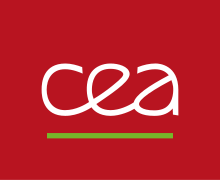Commissariat à l'énergie atomique et aux énergies alternatives
The Commissariat à l'énergie atomique et aux énergies alternatives ( CEA , German Commissariat for Atomic Energy and Alternative Energies ) is a French research center for nuclear energy . It has the legal form of an Établissement public à caractère industriel et commercial (EPIC, German about: corporation under public law with an industrial-commercial character ). It is the joint responsibility of the Ministry of Education and Research, the Ministry of Defense and the Ministry of Economy, Finance and Industry . It was founded on October 18, 1945 by Charles de Gaulle . The first high commissioner was Frédéric Joliot-Curie . The main research centers are in Saclay (Île-de-France), Cadarache (Provence) and Grenoble . Until March 10, 2010, the facility was known as Commissariat à l'énergie atomique ( CEA ).
Areas of responsibility
The CEA is a government research institute that aims to acquire sufficient and advanced knowledge of nuclear processes and their possible applications in the fields of energy, industry, research, health and defense. The CEA also contributes to national efforts in the areas of research and technological innovation and technology transfer to industry. The CEA is a state institution that carries out investigations, has an advisory role, makes proposals and supports the nuclear industry . It also operated the first fast breeder , the Phénix nuclear power plant (130 MW net; not to be confused with the Creys-Malville nuclear power plant ("Superphénix")) from 1973 to 1997 and from 2003 to 2009 together with Électricité de France .
Areas of activity
- Nuclear physics, support for energy policy and the associated basic research
- Continuation of the use of nuclear energy until 2010 and beyond
- Development of alternative, non-fossil energies for the realization of versatile energy systems
- Research into new solutions, particularly in the context of controlled thermonuclear fusion
- Guarantee of French defense capability
- Investigation and recognition of the effects of ionizing radiation and incorporation of the knowledge thus acquired into the development of nuclear medicine
- Investigation of the effects of radiation on matter
- Basic research to understand physical phenomena and the development of the necessary instruments
- Assessment and measurement of the influence of radioactivity on the environment
- Research into and investigation of nuclear safety as part of government decisions
- Innovation and diffusion of technologies
- Development of future microelectronics
- Development of materials, manufacturing processes and related control
- Actions in favor of regional industrial structures and SMEs
- Support government policy in research and technological innovation (promoting the development of technological innovation and research networks)
- Knowledge transfer
- Support of training and teaching at universities and technical colleges
- Ensuring the continuous training of employees in the nuclear industry
- Participation in the forwarding of scientific and technical information
- Participation in the development of SALOME
Key data
- Budget: 2.8 billion euros, of which 1.7 billion euros for activities in the civil sector
- 16,325 researchers, engineers, technicians and administrative employees
- 4 research centers for the military sector
- 5 centers for studies in the civil field: Saclay, Fontenay-aux-Roses, Cadarache , Valrhô, Grenoble
Priorities of cooperation at international level
The CEA guarantees the representation of France at the International Atomic Energy Agency (IAEA) in Vienna. Its work in the field of nuclear fusion is linked to the Euratom Treaty. The CEA teams work with researchers in the same field around the world.
Directorate
High Commissioners (Haut Commissaire) were:
- Frédéric Joliot-Curie (1945–1950), nominated by Charles de Gaulle
- Francis Perrin (1950–1970), nominated by Vincent Auriol , renewed in 1956 by René Coty and in 1961 and 1966 by Charles de Gaulle
- Jacques Yvon (1970–1975), nominated by Georges Pompidou
- Jean Teillac (1975–1993), nominated in 1975 by Valéry Giscard d'Estaing , renewed in 1981 by François Mitterrand
- Robert Dautray (1993–1998), nominated by François Mitterrand
- René Pellat (1998–2003), nominated by Jacques Chirac
- Bernard Bigot (2003–2009), nominated by Jacques Chirac
- Catherine Cesarsky (2009–2012), nominated by Nicolas Sarkozy
- Yves Bréchet (since 2012), nominated by François Hollande
The main administrator and chairman of the board of directors (Administrateurs généraux) were:
- 1945 to 1951, Raoul Dautry
- 1951 to 1958 Pierre Guillaumat
- 1958 to 1963 Pierre Couture
- 1963 to 1970 Robert Hirsch
- 1970 to 1979 André Giraud
- 1978 to 1983 Michel Pecqueur
- 1983 to 1986 Gérard Renon
- 1986 to 1989 Jean-Pierre Capron
- 1989 to 1995 Philippe Rouvillois
- 1995 to 1999 Yannick d'Escatha
- 2000 to 2002 Pascal Colombani
- 2003 to 2009 Alain Bugat
- 2009 to 2014 Bernard Bigot
- from 2015 Daniel Verwaerde
literature
- Bertrand Goldschmidt : Le Complexe atomique. Histoire politique de l'énergie nucléaire. Fayard, Paris 1980, ISBN 2-213-00773-X (French).
- Gabrielle Hecht: Le rayonnement de la France. Energy nucléaire et identité national après la Seconde Guerre mondiale. La Découverte, Paris 2004, ISBN 2-7071-4212-3 (French).
- Marie-José Lovérini: L' Atome , de la recherche à l'industrie. Le Commissariat à l'Énergie Atomique. Gallimard, Paris 1996, ISBN 2-07-053381-6 ( Découvertes Gallimard, Sciences 282), (French).
- Jean-François Picard, Alain Beltran, Martine Bungener: Histoire de l'EDF Comment se sont prises les décisions de 1946 à nos jours. Dunod, Paris 1985, ISBN 2-04-016402-2 ( L'Oeil Économique 2), (French).
Web links
- www.cea.fr , CEA homepage
- www.leti.fr Homepage CEA-Leti (Research Area Microelectronics)
